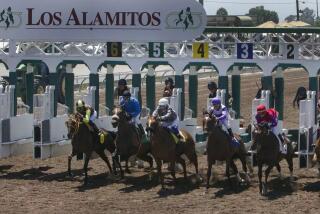But BLM May Destroy 3,000 Animals : Don’t Kill the Wild Horses, Letter Writers Ask
WASHINGTON — More than 4,000 Americans have written the federal keepers of the wild horses of the West, most to express anguish at the possible renewed killing of surplus horses.
The Bureau of Land Management, which imposed a moratorium on killing wild horses and burros in 1982, warned in March that it was considering the destruction of some animals again, perhaps as many as 3,000.
Wild horses--mustangs--compete with millions of head of cattle for forage on the public range.
The bureau, an arm of the Interior Department, has about 7,000 horses in its corrals and expects 10,000 after the summer roundups. It would cost $9.3 million a year to keep that number of animals, and the bureau says it can’t afford it. Though its adoption program has roughly doubled in three years, it still can’t get rid of horses fast enough.
Comment Period Expires
The comment period for the proposed kill expired May 22, and BLM employees are still tallying the letters. The BLM doesn’t expect to make a decision before about July 1.
Of the 2,200 letters opened by May 25, public sentiment was running about 15 to 1 against resumption of killing animals, BLM officials said. More than 2,000 letters remained unopened.
A typical comment, selected just by flipping through the “against” stack, came from John and Ruth Penney of Tulsa, Okla.
“The wanton destruction of these magnificent animals, symbols of freedom and the American West, is repugnant to all decent people,” they said.
Similarly from Paulette Cullen of Nutley, N.J.: “I am once again dumbfounded at what this Administration believes to be the meaning of the word ‘management.’ For the BLM at any rate the word seems to mean its opposite: mismanagement and . . . murder.”
Many criticized what they saw as unjustified help to ranchers, making the point that horses had just as much right to live as any other animals.
At least five groups had provided members with forms addressed to the secretary of the Interior.
In a statement on behalf of 12 animal welfare groups urging Congress to end the roundups, John Grandy, a vice president of the Humane Society of the United States, said: “Public lands may, in fact, be overgrazed. But it’s ludicrous to suggest that removing these wild horses will solve the problems when BLM continues to allow grazing privileges to more than 4.3 million domestic livestock.”
Audubon Society Endorsed Killing
Ranching organizations were prominent in the thin folder of supporting letters, but there were some surprises. The Western region of the National Audubon Society weighed in with a letter backing the bureau’s plans.
Some commentators stressed that wild horses had to be managed like any other wildlife, and if that means culling the herd, so be it.
Some others saw an opportunity. “I think we should feed the wild horses to the poor,” wrote Don Morris of Buena Park, Calif. Another correspondent advocated exporting the meat.
Some people like horse meat. It’s been on the menu at the faculty club of Harvard University since the beef shortages of World War II.
For the state of Massachusetts, Patricia Rule, supervisor of riding academies in the state food and agriculture department, wrote, “The best management practice for limiting herd size is fertility control.” But she did not propose a technique to limit the births of colts.
Current law forbids the bureau from selling the animals for slaughter, but there is no bar to the bureau’s doing the destruction itself, and it has done so in the past. The bureau kills by lethal injection.
It isn’t widely appreciated, but killing is going on now. The bureau veterinarians put down horses that are judged too old, too ill or too lame to keep.
Vernon Schulze of the wild horse and burro office said he had no recent figures on such destruction, but the bureau loses about 8% of its herd each year to those killings, sickness and accidents.
‘One-Time Operation’
“People talk as if we’d kill all 10,000, and keep on doing it, but that’s wrong. This would be a one-time operation of about 3,000. After that, I believe we could adopt out every horse we round up,” said Schulze.
In the current fiscal year, the bureau expects to place 13,000 horses, compared to 6,000 last year, 9,500 the year before and 7,600 the year before that. Burros are not a problem--there is a waiting list for the 1,300 or so that bureau wranglers bring in each year.
The bureau wants to reduce the estimated 44,000 free-running horses, mostly in Nevada, Wyoming, Idaho, Oregon and California, to about 30,000, which it believes the land can support.
Information on horse and burro adoptions is available from any office of the Bureau of Land Management or the public affairs office at bureau headquarters, Room 5600 Main Interior Building, Washington, D.C. 20240.
More to Read
Sign up for Essential California
The most important California stories and recommendations in your inbox every morning.
You may occasionally receive promotional content from the Los Angeles Times.









